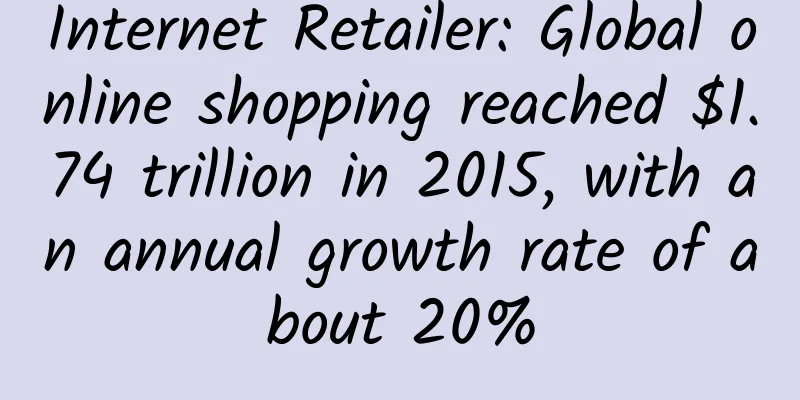Internet Retailer: Global online shopping reached $1.74 trillion in 2015, with an annual growth rate of about 20%

|
The good news for e-commerce retailers around the world and technology companies that provide related services is that the global e-commerce market is huge and is growing rapidly. According to the "Global Top 1000 Report: Innovation in Global E-commerce Retail" just released by Internet Retailer, last year, global consumer e-commerce retail spending reached $1.74 trillion, and over the past three years, the average annual growth rate has been about 20%. The bad news for most retailers who want to establish retail e-commerce businesses is that the global e-commerce market is being monopolized by a few e-commerce giants, and their control over the retail e-commerce market is constantly increasing. If we calculate the gross merchandise volume (GMV), the top ten e-commerce companies in the world, including Alibaba Group and Amazon, which are ranked at the top, almost control half of the global retail e-commerce market. According to Internet Retailer, Alibaba has 27% of the global e-commerce market, while Amazon has 13%. Both companies are the leading e-commerce companies in their respective countries (and relatively small outside their own countries), using a multi-pronged strategy to provide customers with a large number of low-priced products and excellent express delivery services. They have attracted a large number of other third-party sellers to open stores on their e-commerce platforms, providing sellers with convenient options to receive orders from customers all over the world and establish connections with a large group of loyal customers. However, the Global 1000 report points out that there have been some major market share changes among the top companies. For example, Amazon and JD.com both sell their own products, and their revenue from platform sellers continues to grow, and they are both gaining market share in their own countries at a very fast pace. Almost a third of all U.S. e-commerce retail transactions took place on Amazon last year, up from just 12% in 2012. Similarly, JD.com’s market share in China increased from 5.1% in 2012 to 11.3% last year. During this period, Alibaba's e-commerce market share in China has dropped from 81.1% in 2014 to 78.5% last year, despite its sales growth of about 43.4% per year in the past few years. Although Alibaba is still dominant in China, strong competitors such as JD.com are rising rapidly. In the United States, eBay's e-commerce retail market share has been steadily declining in the past few years amid sluggish sales. Although the increasing dominance of the top ten e-commerce giants is bad news for many retail e-commerce companies that want to grab a small piece of the market, many people have chosen to cooperate with Amazon, Alibaba, JD.com and other e-commerce platforms to sell their products on these platforms. (Translated by Hugo.com |
>>: EcommerceBytes: Return Rates on Amazon, eBay, and Etsy
Recommend
Robots can spin pens and roll walnuts! GPT-4 helps robots perform better with more complex tasks
Dear friends, after artificial intelligence (AI) ...
The efficacy and function of water hyacinth
Eichhornia crassipes is a famous traditional comm...
The heat that starts high and ends low! Is there an "absolute zero" between the sun and the earth?
The Sun, as the closest star to us, provides ligh...
Chocolate, ice cream... add it to become "luxurious"? Latest notice: non-food raw materials
"There's some gold foil on the chicken n...
What are the effects of nard
There are many varieties of traditional Chinese m...
Popular Science Illustrations | Dual-fuselage layout! "Venus 50" successfully made its maiden flight
...
The Boeing accident was unusual. Where was the fatal bug?
1. Starting from the EgyptAir crash Xiaobai: The ...
Which one makes you gain weight more easily, eating noodles or eating rice?
Review expert: Wang Xuejiang, Professor of Pathop...
The efficacy and function of mountain black pearl leaves
The leaves of the mountain aconite are a very com...
That Day丨It turns out that Yang Liwei flew into space 20 years ago!
20 years ago today A glorious page in the history...
White dragon beard herbal pictures
White Dragon's Beard is actually the root of ...
The person who commands the satellite in the sky only listens to her orders!
Sun Jiadong, the hero of "Two Bombs and One ...
The efficacy and function of mountain hemp stem
Shanma gan is one of the common traditional Chine...
The efficacy and function of Chun Bu Jian
Since Chinese medicine has fewer side effects, mo...
The efficacy and function of Shengdi
Shengdi may be somewhat unfamiliar to everyone. In...









